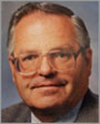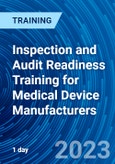Introduction
Recent US FDA inspections indicate the past ways of doing things will no longer be acceptable. Increasingly reports from the field indicate that the Agency is using high-profile cases to drive compliance to smaller companies and suppliers. See how the on-site CGMP compliance audit is changing and the FDA focus is shifting. Recognizing what to expect during an FDA inspection enables a medical device manufacturer to effectively prepare for the inspection. This webinar will focus on how to prepare domestic and foreign medical device manufacturers selling to the U.S. to recognize and prepare for FDA pre- and post-market inspections.
As a medical device manufacturer, you have the responsibility to adhere to the highest product standards and serve the intended purpose. Be it the simplest device to check regular health parameters or a surgical assistance device - it is essential to pass the audits conducted by international regulatory agencies.
The agencies evaluate your device, its features, and quality, and make sure it complies with the laws stated by the government. Since a medical device industry audit comprises multiple systematic layers, you will likely miss certain criteria. As a result, it might hamper the license of your manufacturing unit.
To do away with such risks, the host has come up with a well-curated instructor-led seminar to help you understand the depths of medical device audits.
Course Overview
There has been a major shift in the emphasis of U.S. FDA CGMP compliance audits over the past few years.
This change in focus has a major impact on individual compliance objectives, efforts, and measurements of success. The Agency has come under increasing negative publicity due to recent food, device, drug, vaccine, and infant formula shortage problems. This affects the Agency's approach to audits and their expectations for companies, with emphasis on the key CGMP areas under QSIT. This course focuses on identifying FDA inspection criteria, resources (including key standard operating procedures such as CP 7382.845), and practices used to plan, conduct, and assess inspections of medical device manufacturers. It walks participants through a "typical" new, tougher CGMP compliance audit. It will figuratively "look over the shoulder" of an investigator as they walk through a device plant and perform an audit, based on the always changing regulatory climate.
Since customers cannot perform these audits and differentiate between a good and a poor quality product - it is the responsibility of government bodies to ensure medical device safety. Additionally, these quality management system clearances are required for the marketing of the product in an appropriate way.
These audits are essential to move on to surveillance and recertification audits. Even though the frequency of audits depends on the class of medical device, it is crucial to meet the basic criteria in all the audits.
Course Content
- Identify key requirements of the FDA’s Quality System (21 CFR Part 820)
- Key similarities and differences between 21 CFR Part 820, ISO 13485:2016, and the tougher FDA positions
- The key focus of FDA’s Quality System Inspection Technique (QSIT) - 15 to 7 to 4
- A typical FDA CGMP inspection sequence
- Documentation/records issues
- Design Control / Design and Development Planning
- Virtual Inspections / Audits
- Preparation for FDA Inspections
- What to immediately do after notification of the inspection
- Immediate, full, and sequential inspection responses to the Agency
Course Provider

John E. Lincoln,
Principal Consultant ,
J. E. Lincoln and Associates LLCJohn E. Lincoln is principal of J. E. Lincoln and Associates LLC, a consulting company, with over 33 years’ experience in U.S. FDA-regulated industries and 20 years as a full-time consultant. He has worked with companies from start-up to Fortune 100, in the U.S., Mexico, Canada, France, Germany, Sweden, China and Taiwan.
He specializes in quality assurance, regulatory affairs, QMS problem remediation and FDA responses, new / changed product 510(k)s, process/ product/ equipment including QMS and so+E6ftware validations, ISO 14971 product risk management files / reports, design control / design history files, and technical files. He's held positions in manufacturing engineering, QA, QAE, regulatory affairs, to the level of director and VP (R&D). In addition, Mr. Lincoln has prior experience in military, government, electronics, and aerospace. He has published numerous articles in peer reviewed journals, conducted workshops and webinars worldwide on CGMP subjects. He is a graduate of UCLA.
Who Should Attend
This seminar is tailor-made for the entire quality management team in a medical device manufacturing unit. Below are some professionals who will benefit from this training:
- Managers & Supervisors: Assess the quality of work and guide beginners to keep the protocol uniform in all the steps
- Quality Analysts & Internal Auditors: Makes it easier to figure out loopholes and bridge the gaps before the final FDA or EPA inspections
- Production Team: Helps them get a clear idea of how to regulate the entire process to make it favourable for the product during audits and inspections
- Scientists & Research Associates: As a principal investigator, you will be able to direct the entire course of the experiment for the team
- All Personnel Involved in a U.S. FDA-Regulated Environment









